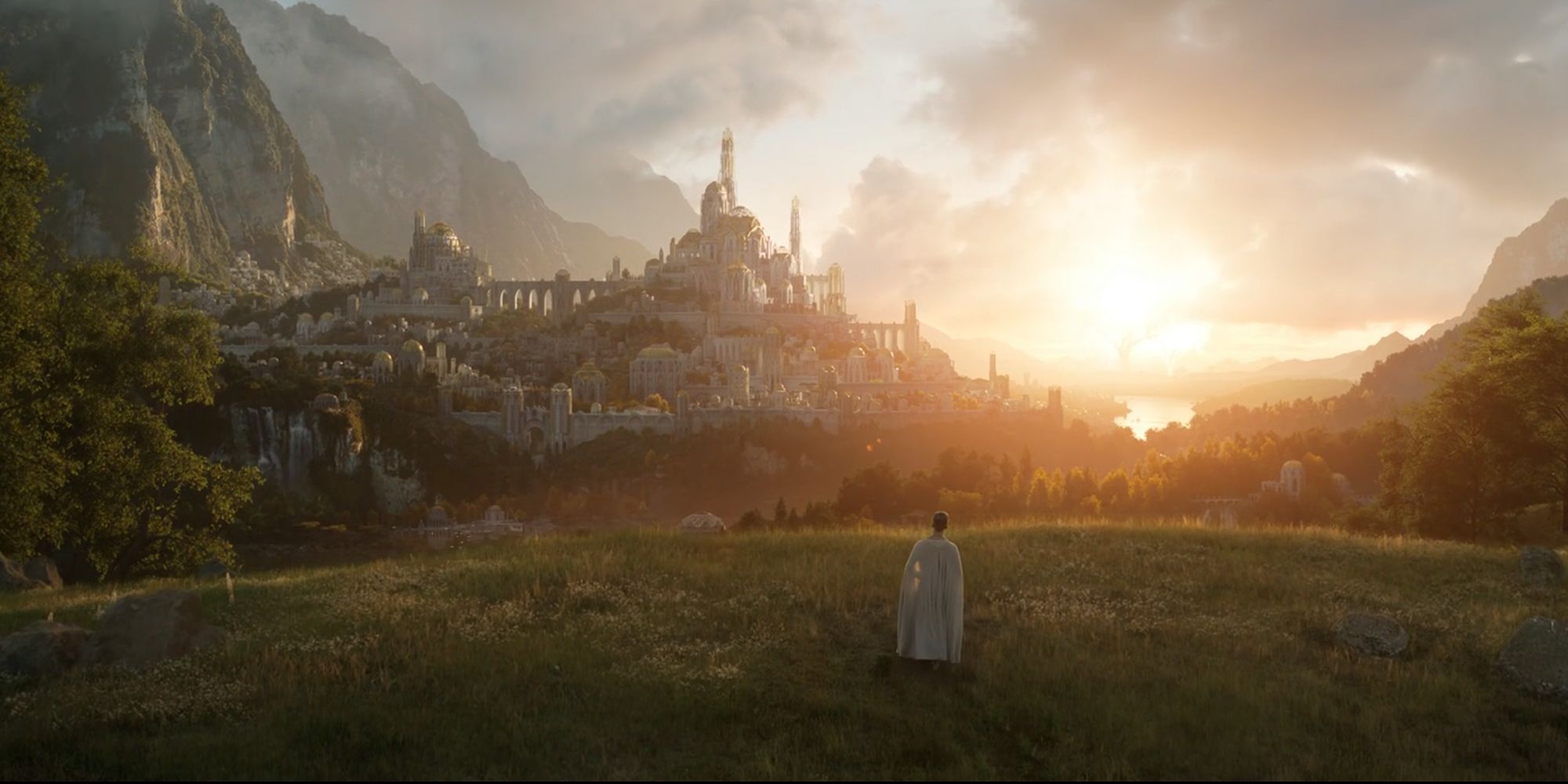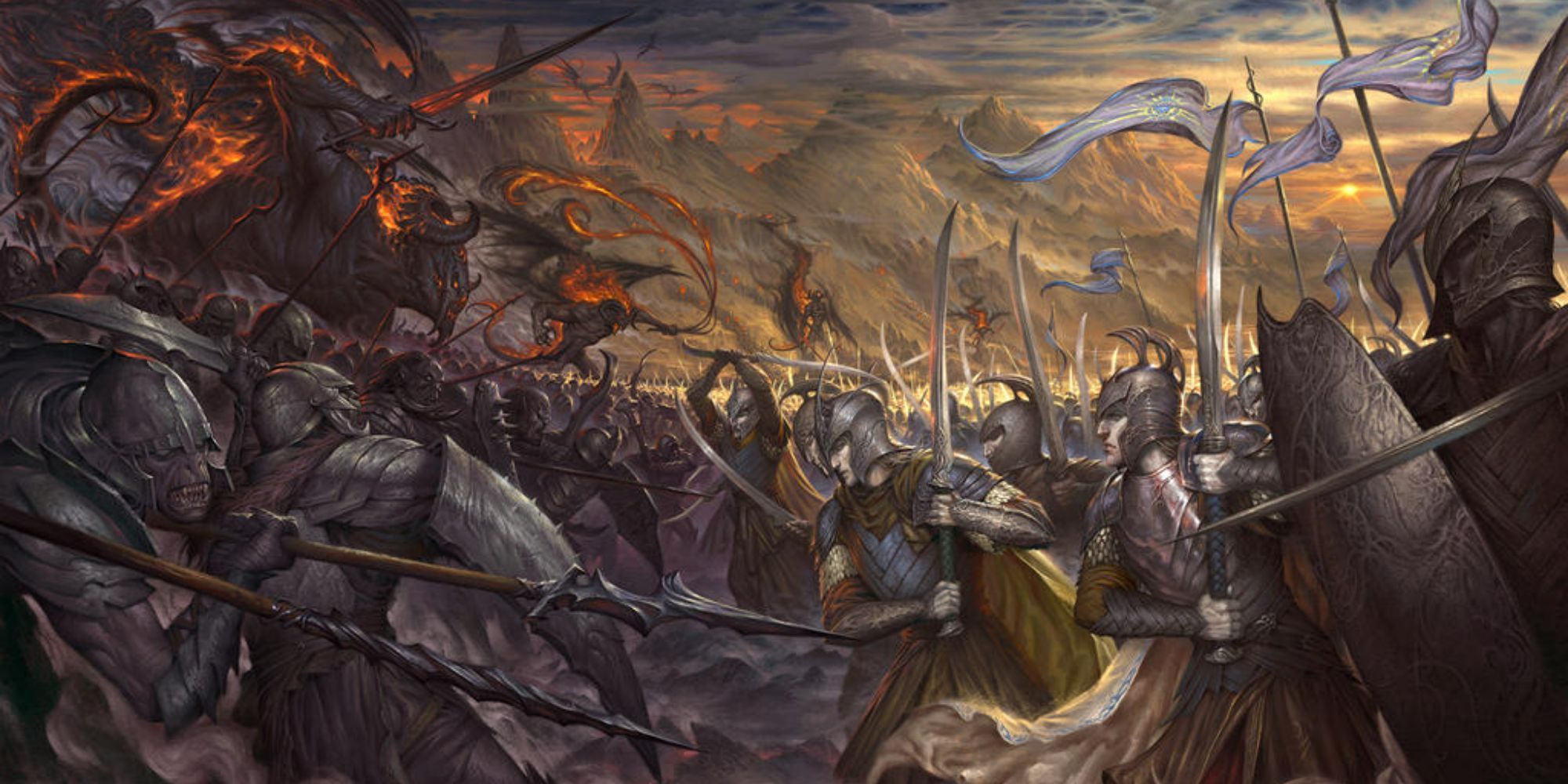
Morgoth was the original villain of J.R.R. Tolkien’s legendarium, but he had been defeated long before the events of The Lord of the Rings, leaving the novel’s eponymous villain to take center stage. Destructive Vala Morgoth was referenced in Tolkien’s seminal novel, The Lord of the Rings, but was detailed in The Silmarillion. Morgoth’s antics were relegated to the First Age and before, whereas Amazon Prime Video’s The Lord of the Rings: The Rings of Power takes place in the Second Age and the Warner Bros. movies take place in the Third Age.
Morgoth’s defeat in the First Age was so demanding that it changed the structure of Middle-earth forever. This was so significant in Middle-earth’s history that it started Middle-earth’s Second Age, ending the First. But the intriguing details of Morgoth’s defeat were only implied in The Lord of the Rings’ appendices, with the full story entailing numerous battles that culminated in what was probably the worst war in Middle-earth’s history. And yet, in a way, the story of Morgoth’s defeat began at the very start of time.
Morgoth Was Initially Taken Back To Valinor By The Valar (But Returned To Middle-Earth)
The Valar Forgave Morgoth For His Crimes, Initially










Before the universe had been made, the semi-divine Morgoth wanted to rival Middle-earth’s God, Eru Ilúvatar, leading him to rebel against Eru and his agents, who forgave his indiscretions on numerous occasions. Living in the Timeless Halls with Eru and the other Ainur, Morgoth searched the Void for the Imperishable Flame, which was the gift of life itself, and Eru’s alone to give. He was unable to find it. While singing with other Ainur in the song that visualized the creation of Arda, Morgoth introduced discord, arrogantly dissatisfied with Eru’s theme.
Putting this aside, Morgoth was allowed to descend into Arda as one of the 15 Valar – Tolkien’s demigods. Together, they built Arda. However, Morgoth wanted total control and continually sabotaged the other Valar’s work. He destroyed their first source of light, the Two Lamps, and was eventually captured and imprisoned by the Valar. His sentence passed and the Valar let him roam Valinor under their supervision. But again, Morgoth stole Arda’s light, destroying the Two Trees and fleeing to Middle-earth.
The Valar Refused To Fight Morgoth Until Eärendil Intervened
Eärendil Begged The Valar For Their Help In Fighting Morgoth

Morgoth was unleashed on Middle-earth, following his escape from Valinor. At this point, the Valar began to withdraw their intervention from Middle-earth. Morgoth had stolen the Silmarilli from the Noldor – three great jewels forged by the great Noldorin Elf, Fëanor. Inflamed by pride and vengeance, Fëanor and his sons pursued these jewels to the ends of Middle-earth, and the great Battles of Beleriand ensued. Morgoth’s forces and the Noldor alike spilled much innocent blood. But the Valar were absent from the Battles of Beleriand.
Eventually edited and published by Tolkien’s son, Christopher, The Silmarillion was released in 1977, four years after Tolkien’s passing.
The Valar had warned the Noldor off their bloody pursuit of the Silmarilli but their warning went unheeded. Therefore, the Valar had exiled the Noldor Elves, but still watched from afar and cared after the fate of all Elves, creating new sources of light – the Sun and Moon. It was not bitterness that fueled the Valar’s withdrawal, but fear of the impact that their fighting would have on Middle-earth, knowing how destructive it had been before the Elves awoke and knowing that Men were soon to awaken in Hildórien. Eventually, the half-Elven Eärendil begged for the Valar’s help.
The First Age’s War Against Morgoth Explained
The First Age Culminated In The War Of Wrath

The Valar had enacted the Hiding of Valinor, setting their continent of Aman behind Enchanted Isles in the Shadowy Seas. This protected their realm from Morgoth and also kept the Noldor out, ensuring mariners were somehow waylaid. Only one mariner made it to Valinor – Eärendil. Eärendil asked the Valar to pity the Noldor and aid them in their failing struggle against Morgoth, and his request was granted. The Valar sent an army to Middle-earth and the cataclysmic War of Wrath occurred. Morgoth’s dragons fought in the war and the greatest, Ancalagon, was killed by Eärendil.
Tolkienian Age
Event Marking The Start
Years
Total Length In Solar Years
Before time
Indeterminate
Indeterminate
Indeterminate
Days before Days
The Ainur entered Eä
1 – 3,500 Valian Years
33,537
Pre-First Age Years of the Trees (Y.T.)
Yavanna created the Two Trees
Y.T. 1 – 1050
10,061
First Age (F.A.)
Elves awoke in Cuiviénen
Y.T. 1050 – Y.T. 1500, F.A. 1 – 590
4,902
Second Age (S.A.)
The War of Wrath ended
S.A. 1 – 3441
3,441
Third Age (T.A.)
The Last Alliance defeated Sauron
T.A. 1 – 3021
3,021
The War of Wrath was so devastating to Middle-earth that it sunk the majority of the realm of Beleriand, leaving just a small portion of it above water. This proved that the Valar were right to have been concerned about the effect of their military involvement in Middle-earth. Nonetheless, it was crucial to put Morgoth’s threat to bed once and for all, and this is what the War of Wrath did. Although so devastating that it ended the First Age, the War of Wrath saw Morgoth defeated and imprisoned again, but much more permanently than the last time.
Morgoth Was Imprisoned By The Valar (But Not Killed)
Morgoth Was Cast Into The Void

As an Ainur spirit-being, Morgoth couldn’t be killed, so he was cast into the Void by the Valar through the single entrance and exit, the Doors of Night. The Doors of Night were sealed and guarded forevermore by Eärendil. This was Eärendil’s sentence for entering Valinor beyond his exile. In a complex interplay of fate and free will, Eärendil was destined to enter Aman but was not supposed to. Since stepping foot on Aman, Eärendil never saw Middle-earth again but bore the one Silmaril that he carried on his brow.
In The Silmarillion, Tolkien referenced a prophecy that discussed Morgoth’s return from the Void for a final battle called the Dagor Dagorath…
Eärendil, therefore, became one of the brightest stars in the sky. This light, reflected in Galadriel’s mirror, was later captured in Galadriel’s phial and given to Frodo in The Lord of the Rings, helping him defeat Shelob. Meanwhile, Morgoth was trapped in the Void. In The Silmarillion, Tolkien referenced a prophecy that discussed Morgoth’s return from the Void for a final battle called the Dagor Dagorath, but Christopher didn’t include the full prophecy in the final edit. However, subsequent publications of Tolkien’s work implied that Tolkien took the prophecy seriously.





